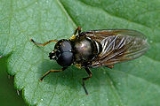
Cheilosia albipila
Encyclopedia
Cheilosia albipila is a Europe
an and Asia
n species of hoverfly
. Like most Cheilosia
it is black, and because of this may often be overlooked as a hoverfly. It is little recorded but probably widespread and common and maybe overlooked because adult flight periods are early in the year, before many hoverfly recorders are active.
to south of the Pyrenees
, and from Ireland
eastwards through much of northern and central Europe
and European parts of Russia
and central Siberia
.
e of C. albipila feed inside the base of the stems of Marsh Thistles (Cirsium palustre
')
Adult Females lay eggs in the rosettes of mature plants in early spring when adults are most active. Usually there is only one larvae per plant and they feed by tunnelling up the pith
y centre of the main thistles stem.
The larvae mature about mid to late June in southern UK and then leave the plant to pupate in the soil around the thistle. Flight times of adults are Late February to May, peeking around mid April.
Europe
Europe is, by convention, one of the world's seven continents. Comprising the westernmost peninsula of Eurasia, Europe is generally 'divided' from Asia to its east by the watershed divides of the Ural and Caucasus Mountains, the Ural River, the Caspian and Black Seas, and the waterways connecting...
an and Asia
Asia
Asia is the world's largest and most populous continent, located primarily in the eastern and northern hemispheres. It covers 8.7% of the Earth's total surface area and with approximately 3.879 billion people, it hosts 60% of the world's current human population...
n species of hoverfly
Hoverfly
Hoverflies, sometimes called flower flies or syrphid flies, make up the insect family Syrphidae. As their common name suggests, they are often seen hovering or nectaring at flowers; the adults of many species feed mainly on nectar and pollen, while the larvae eat a wide range of foods...
. Like most Cheilosia
Cheilosia
Cheilosia is a genus of hoverfly. Most Cheilosia are black or largely un-coloured, lacking the bright colours and patterns of many hoverfly species. It is one of the most species diverse genera of hoverflies...
it is black, and because of this may often be overlooked as a hoverfly. It is little recorded but probably widespread and common and maybe overlooked because adult flight periods are early in the year, before many hoverfly recorders are active.
Distribution
It is distributed from ScandinaviaScandinavia
Scandinavia is a cultural, historical and ethno-linguistic region in northern Europe that includes the three kingdoms of Denmark, Norway and Sweden, characterized by their common ethno-cultural heritage and language. Modern Norway and Sweden proper are situated on the Scandinavian Peninsula,...
to south of the Pyrenees
Pyrenees
The Pyrenees is a range of mountains in southwest Europe that forms a natural border between France and Spain...
, and from Ireland
Ireland
Ireland is an island to the northwest of continental Europe. It is the third-largest island in Europe and the twentieth-largest island on Earth...
eastwards through much of northern and central Europe
Europe
Europe is, by convention, one of the world's seven continents. Comprising the westernmost peninsula of Eurasia, Europe is generally 'divided' from Asia to its east by the watershed divides of the Ural and Caucasus Mountains, the Ural River, the Caspian and Black Seas, and the waterways connecting...
and European parts of Russia
Russia
Russia or , officially known as both Russia and the Russian Federation , is a country in northern Eurasia. It is a federal semi-presidential republic, comprising 83 federal subjects...
and central Siberia
Siberia
Siberia is an extensive region constituting almost all of Northern Asia. Comprising the central and eastern portion of the Russian Federation, it was part of the Soviet Union from its beginning, as its predecessor states, the Tsardom of Russia and the Russian Empire, conquered it during the 16th...
.
Biology
The larvaLarva
A larva is a distinct juvenile form many animals undergo before metamorphosis into adults. Animals with indirect development such as insects, amphibians, or cnidarians typically have a larval phase of their life cycle...
e of C. albipila feed inside the base of the stems of Marsh Thistles (Cirsium palustre
Cirsium palustre
Cirsium palustre, the marsh thistle or European swamp thistle, is a herbaceous biennial species of the genus Cirsium. It is a tall thistle which reaches up to in height. The strong stems have few branches and are covered in small spines...
')
Adult Females lay eggs in the rosettes of mature plants in early spring when adults are most active. Usually there is only one larvae per plant and they feed by tunnelling up the pith
Pith
Pith, or medulla, is a tissue in the stems of vascular plants. Pith is composed of soft, spongy parenchyma cells, which store and transport nutrients throughout the plant. In eudicots, pith is located in the center of the stem. In monocots, it extends also into flowering stems and roots...
y centre of the main thistles stem.
The larvae mature about mid to late June in southern UK and then leave the plant to pupate in the soil around the thistle. Flight times of adults are Late February to May, peeking around mid April.

